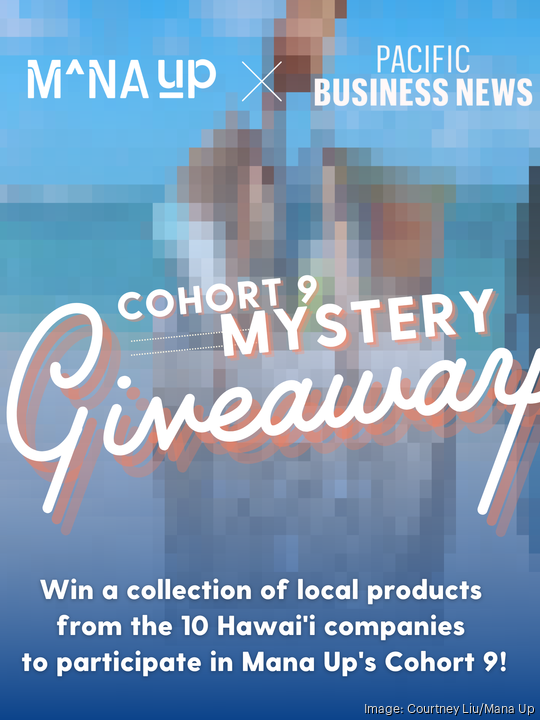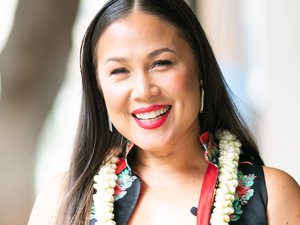
When Meli James and Brittany Heyd launched Mana Up in 2017, they had a vision to diversify Hawaii’s economy and expand job opportunities by helping local product companies scale globally.
Today, the organization is realizing that vision.
Mana Up’s product accelerator program is designed for consumer brand businesses that are based in Hawaii and have the potential to expand internationally. To date, 85 local companies have graduated from the program, with alumni businesses including well-known names such as Mohala Eyewear, keiki clothing company Coco Moon, and frozen treat brand Banan, just to name a few.
James recently told Pacific Business News that Mana Up companies brought in $81 million in revenue last year alone. Those companies represent 874 jobs, and they’re growing at a mean rate of 33% annually, she said.
Now, Mana Up is gearing up to host its next cohort, Cohort 9, which is comprised of 10 product businesses from throughout the state.
PBN is partnering with Mana Up to announce the cohort members, with profiles on each company slated to roll out beginning tomorrow through Tuesday, June 4. So stay tuned to pacificbusinessnews.com, and check out the June 7 print edition for the full roundup.
This year’s cohort was selected from what James said was “another record-breaking year of applications.”
“We had 163. Every year grows, which is pretty incredible when you think about small business growth and new business growth — so it was awesome just to see that number again increase,” she said.
Among the applicants, 60% of businesses were from Oahu, 18% from Maui, 15% from Hawaii Island, 5% from Kauai and 2% from Molokai.
About a quarter of the applicants had over $500,000 in annual revenue, another quarter were in the $100,000-$500,000 range, and half had under $100,000.
And that’s just for now. James noted that one trend from this year’s applicant pool is that a lot of them “seem to be really optimistic about their future.” On average, she said, the companies expect to grow their revenue by 20% year-over-year in 2024.
The applicant businesses had an average of 2.92 employees.
“When you think about what is the whole point of this — about jobs, and growing businesses that can create those jobs — it’s really neat to see that a lot of these companies already have a couple of employees,” she said.
To select the final participants — a task James admitted is not easy — Mana Up conducts an interview process that “really digs into why they started the company, what they are excited about, why people love their products, and what they are working on,” James said.
This year’s cohort spans industries including agriculture, art, beauty, clothing and more.
One prominent trend among this year’s group, James noted, is that about half of the companies are creating innovative products sourced from local agriculture.
“They’re sourcing local agriculture — which we love — and they’re creating a unique product through that,” she said.
It’s products like that, she said, that demonstrate how Hawaii companies can be “the best in class, and sometimes the first in class, to do things.”
The six-month accelerator program kicks off with the first session on June 4.
Programming will include workshops, talks with local business leaders, one-on-one coaching and other resources. Topics covered throughout the program are specific to product companies — focusing on things like inventory, distribution, packaging and e-commerce.
Beyond that, the programming is also personalized to each individual company.
“We do deep dives into these companies,” James said. “We actually meet with each company individually — we visit their manufacturing facility, their store, so we can really get into the guts of what’s going on. [We want to see] what they are working on, what are the barriers, where are the bottle necks.”
At the end of the program, James anticipates the Cohort 9 companies will be poised to scale — with new sales channels, clear brand messaging and stronger infrastructure.
Once these 10 companies graduate in the fall, Mana Up will have a total of 95 businesses in its portfolio. As those portfolio companies continue to grow, James said Mana Up is building out programming for alumni that addresses later-stage challenges — things like hiring and creating company culture — to help spur further growth.
It all goes back to her and Heyd’s initial goal of helping to create new opportunities in Hawaii’s economy.
“Now over half of our alumni companies are over $1 million in revenue,” James said. “What is that next jump — how do we help them get to $10 million and beyond? And what does that look like for our state when we are talking about $1 billion, $2 billion of contributed revenue and jobs? That gets very interesting from a critical mass standpoint for interesting jobs, management-level jobs and the kinds of jobs we want here.”
A 'mystery giveaway' featuring Cohort 9
In conjunction with the announcement of Cohort 9 companies, Mana Up is holding a giveaway of a “mystery gift set featuring products from all 10 companies.” According to Mana Up, the gift set is valued at $1,000.

Here's how to enter:
- Go to Mana Up’s Instagram page @manauphawaii and visit the link in the bio
- Follow @pacificbusinessnews and @manauphawaii on Instagram
- Tag two friends you'd share these local goodies with in the giveaway post here.
For the person who wins, James said they “will be the first to get all of these awesome new products” from the cohort companies.
The giveaway closes on Tuesday, June 4.








